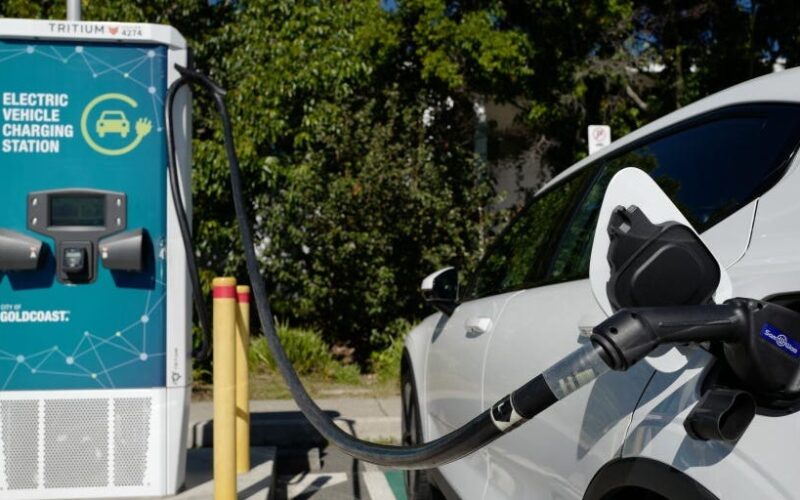Surveys have shown that consumers are turning away from EVs due to concerns about cost, charging, and range. All of these have their roots in the most expensive and crucial part of any electric vehicle — the battery.
Jason Koeller, cofounder of battery startup Chemix, thinks that could change, thanks to AI.
“When you think about EV adoption, nearly all of the reasons why people don’t want to buy EVs have something to do with the battery,” he told Business Insider.
“Either it’s too expensive or the range isn’t long enough, it doesn’t charge fast enough, or there are perceived safety concerns — whatever it is, it all boils down to the battery,” he added.
The AI wave hits EVs
California-based Chemix, which raised $20 million in investment in April, is one of several startups and research labs looking to solve many of these issues with the help of AI.
Chemix is using machine-learning algorithms to develop EV batteries that can charge more quickly, hold more energy, and last longer than current EV power units.
Another common complaint drivers have about EVs is their tendency to lose performance in hotter and colder climates, an issue Chemix’s custom-designed batteries could help address.
The startup’s AI tech can also be used to filter out common battery materials, such as nickel and cobalt, that have been linked to human rights abuses.
Koeller said the primary advantage of using AI to design EV batteries is that it dramatically speeds up the process. A 2020 study in Nature found that machine learning models could reduce the time it took to identify a fast-charging battery design from 500 days to 16.
“The problem we’re solving is really to speed up the pace of battery development,” Koeller said, adding that this would be crucial to producing EVs that can hold their own against combustion-engine counterparts.
“We’re definitely going to need significantly better battery performance and it’s our belief that the way that we get there is by doing battery development in a fundamentally different way,” he added.
Better EV batteries
Designing EV batteries is a three-step process, Georgia Tech assistant professor Micah Ziegler told BI.
Scientists must first decide on a structure and combination of elements that will produce a battery material with the desired properties before developing a recipe to synthesize it and testing that material in a lab.
The sheer number of potential combinations and the variety of demands placed on EV batteries — including longevity, safety, cost, and charging speed — makes designing batteries a lengthy and difficult process, Ziegler said.
“The number of options is just vast. Once you start putting different elements together, we’re talking about potentially trillions of different combinations,” he added.
AI could dramatically speed up this process, identifying potentially promising combinations far quicker than humans can.
Karl Mueller, a physical chemist at the Pacific Northwest National Laboratory, described battery design as an “Edisonian” task: a drawn-out process of trial and error in which scientists compare and tweak billions of chemical combinations.
“The process is slow, and it can take years to find new materials and modify them,” he told BI.
PNNL recently teamed up with Microsoft to discover a promising new material for making EV batteries using the latter’s AI and cloud-computing technology.
The solid-state electrolyte they discovered relies less on lithium, an increasingly rare resource that forms the core of today’s EV batteries. It is also less likely to catch fire than lithium-ion batteries.
‘It’s going to be phenomenal’
Mueller said incorporating AI into PNNL’s workflow allowed the lab to dramatically speed up the process of whittling down 32 million possible chemical combinations to around 20 potential battery designs.
“The newest AI tools that we’ve been working on with Microsoft, it’s allowed us to design for specific properties and to weed out things early that we believe won’t have those properties,” he said.
“It’s going to be phenomenal for speeding up the discovery process. I think it’s going to drive the speed of the discovery for what we need to do to allow for more electrification and better electric vehicles,” Mueller added.
The hype around generative AI may be fading in some quarters, but one area where it’s already reaping clear benefits is the scientific community.
Models such as DeepMind’s AlphaFold 3 have improved the mapping of complex biological proteins, potentially opening up new opportunities for researchers to quickly develop life-saving drugs.
Mueller said that PNNL’s collaboration with Microsoft has convinced him that generative AI could have applications far beyond speeding up EV battery design.
“This idea of building science agents based around large language models and coupling that to these discovery workflows, is very, very exciting,” he said.
“I think in a year or two we’re not going to recognize where science has got to.”
Source link
lol

